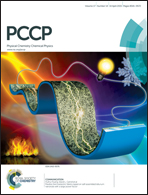Trends in the adsorption and reactivity of hydrogen on magnesium silicate nanoclusters†
Abstract
We study nanoclusters of Mg-rich olivine and pyroxene (having (MgO)6(SiO2)3 and (MgO)4(SiO2)4 compositions) with respect to their reactivity towards hydrogen atoms, using density functional calculations. Ultrasmall silicate particles are fundamental intermediates in cosmic dust grain formation and processing, and are thought to make up a significant mass fraction of the grain population. Due to their nanoscale dimensions and high surface area to bulk ratios, they are likely to also have a disproportionately large influence on surface chemistry in the interstellar medium. This work investigates the potential role of silicate nanoclusters in vital interstellar hydrogen-based chemistry by studying atomic H adsorption and H2 formation. Our extensive set of calculations confirm the generality of a Brønsted–Evans–Polanyi (BEP) relation between the H2 reaction barrier and the 2Hchem binding energy, suggesting it to be independent of silicate dust grain shape, size, crystallinity and composition. Our results also suggest that amorphous/porous grains with forsteritic composition would tend to dissociate H2, but relatively Mg-poor silicate grains (e.g. enstatite composition) and/or more crystalline/compact silicate grains would tend to catalyse H2 formation. The high structural thermostability of silicate nanoclusters with respect to the heat released during exothermic H2 formation reactions is also verified.


 Please wait while we load your content...
Please wait while we load your content...